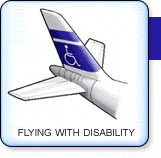|
|
Flying With Disability
| Oxygen |
|
Just because you need to travel with oxygen, need not restrict the opportunities to travel it just takes a little bit more planning. Flying with Disability offers you the following advice to ensure a safe, happy flight.
Travellers who require oxygen for medical use are, unfortunately, subject to a charge per bottle. This rate varies between airline, and can be quite expensive. You will need to contact the airline at least 48hrs prior to flying to advise the flow rate, and to get full medical clearance, though this tends to be minor technicality.
In the US the FAA requires a physicians statement outlining your needs for oxygen. Please note though that some airlines require 7 days notice, so we recommend that you check with your airline as soon as you know that you are flying to avoid any complications.
You will be able to carry your own oxygen cylinders for a flight, though these cylinders must be empty with the intention of filling and using them at your destination. When checking in, you have to be able to prove to airline security staff that the oxygen canisters you are carrying are empty. These canisters cannot be checked in with your luggage, and you'll have to carry them onto the flight, though they won't constitute a component of your luggage allowance.
Charges for oxygen can vary greatly, usually between £30 and £100 ($50 - $150). It is interesting to note that many airlines charge not per canister, but per leg of your trip. So in a flight which involves two legs, you're going to be charge twice as much a direct flight, despite the fact that you may be covering the same distance in the same length of time.
Economically, therefore, it can work out a lot cheaper if you can organise a direct flight, though this may not always be possible.
|
|
|
